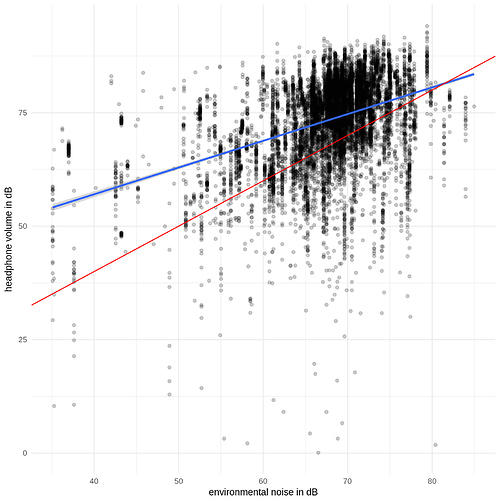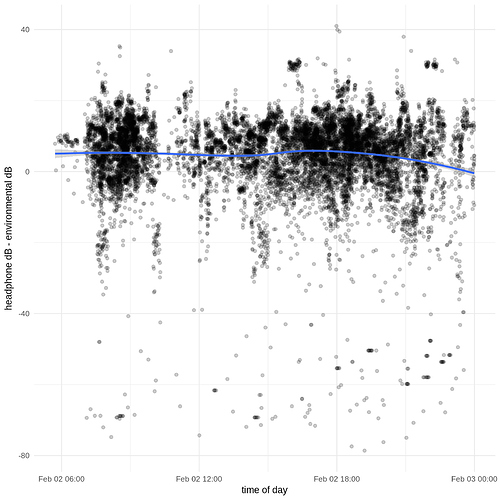I couldn’t help myself and gave this a quick try for myself using the historical data I had already collected through Apple HealthKit and the iPhone/Watch. I exported the dB levels for the headphone volume and environmental noise, tried to match those recordings and plotted daily variation for those two categories:
The top is the headphone dB, the bottom is the environmental noise throughout the day. I censored the graph to only give rough waking hours, as the sleep phase is rather boring (I’m usually not playing music through my headphones during those times). There doesn’t seem to be a strong signal in neither the environmental noise nor the music playing.
For the environmental noise it seems that there’s a slight dip during the middle of the day when it comes to noise, which intuitively makes sense to me, as I usually commute during the mornings & evenings and the city noises should be louder than my office.
For the headphones there is a similar trend to be observed, but of course that is largely because those two variables are connected: If the environmental noise is louder, I need to push up the headphone volume in order to hear anything:
We can see this correlation pretty nicely in the graph (blue line), compared to the hypothetical diagonal (red line). The louder the environment, the louder I listen to things on my headphone. Due to this effect it might not make much sense to just look at the raw headphone volume throughout the day as peaks are expected.
As a simple try to correct for this I calculated the difference between (headphone volume - environmental noise) and plotted those values throughout the day:
Here we again don’t find a lot of signal as the loess fit is more or less linear throughout the day. It looks that for me there’s no clear signal to be seen so far between the volume I play audio through my headphones and the time of day. Of course this is all pretty simplistic and there’s some things to keep in mind:
Caveats:
- the environmental noise recordings are much less frequent than the recordings for the headphone volume (~ 5x more data for the headphones than for environmental noise), as a result the same environmental noise recording is reused multiple times to correlate with the headphone data. We can see this in the first figure where lots of environmental noise data is overlapping, appearing as a line. As a result the environmental noise data might be off quite a bit.
- I usually don’t use my phone to listen to music/podcasts etc. when in the office, so there’s comparatively few data points between ~9am-7pm, which biases the data set to other locations.
- Correcting by the environmental noise levels might be problematic for Rolands original question on hearing sensitivity. If the hearing sensitivity changes throughout the day this will probably affect most things equally, thus we loose that signal.
Based on all of this I’d say that doing more standardized hearing tests at different times of the day are probably more useful than the large-scale data collection. 



